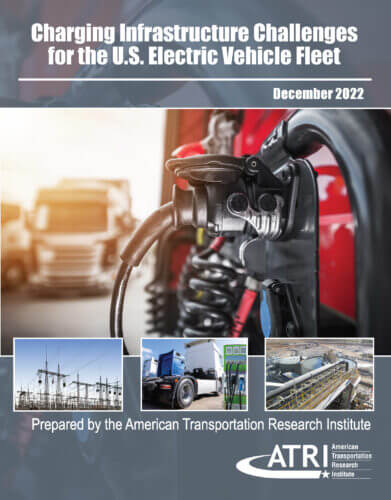The American Transportation Research Institute (ATRI) has released a new report that assesses the infrastructure requirements for converting the U.S. vehicle fleet to battery electric. This analysis, a 2021 top priority of ATRI’s Research Advisory Committee, focused on three critical challenges for nationwide vehicle electrification: U.S. electricity supply and demand, electric vehicle production, and truck charging requirements.
The study found that full electrification of the U.S. vehicle fleet would require a large percentage of the country’s present electricity generation. Domestic long-haul trucking would use more than 10% of the electricity generated in the country today – while an all-electric U.S. vehicle fleet would use more than 40%. Some individual states would need to generate as much as 60% more electricity than is presently produced.
ATRI’s analysis also quantified the tens of millions of tons of cobalt, graphite, lithium and nickel that will be needed to replace the existing U.S. vehicle fleet with battery electric vehicles (BEV), placing high demand on raw materials. Depending on the material, electrification of the U.S. vehicle fleet would require 6.3 to 34.9 years of current global production. This is the equivalent of 8.4 to 64.4% of global reserves for just the U.S. vehicle fleet.
Finally, it was found that charging the nation’s long-haul truck fleet will prove challenging, partially due to the ongoing truck parking crisis. Current technology will necessitate more chargers than there are truck parking spaces in the U.S., with hardware and installation costs of $112,000 per unit, or more than $35 billion system-wide.
“Carbon-emissions reduction is clearly a top priority of the U.S. trucking industry, and feasible alternatives to internal combustion engines must be identified,” says Srikanth Padmanabhan, president of Cummins Inc.’s Engine Business. “ATRI’s research demonstrates that vehicle electrification in the U.S. will be a daunting task that goes well beyond the trucking industry – utilities, truck parking facilities and the vehicle production supply chain are critical to addressing the challenges identified in this research. Thus, the market will require a variety of decarbonization solutions and other powertrain technologies alongside battery electric.”
Beyond BEV automobiles, the report concludes that while there are certain applications for BEV trucks, a completely new charging infrastructure is critical to increasing BEV truck adoption by the trucking industry. Furthermore, the research documents that existing raw material mining for BEV batteries will likely need to be re-sourced with an emphasis on domestic mining and production.
Read the full report here.





